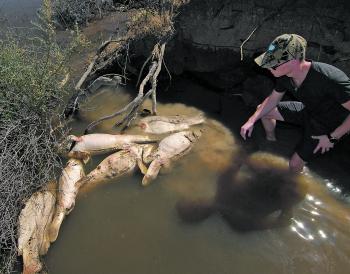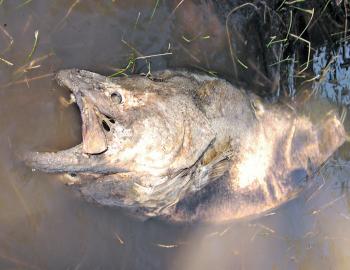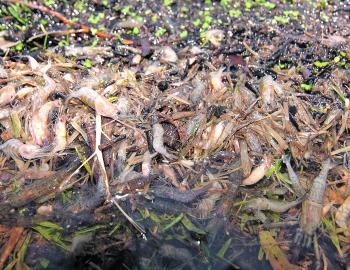We look for the good news in fishing reports. Unfortunately, that’s not the case here. It must be reported, so we all know the truth – with such water-borne bounty swelling our lakes and rivers these past few months, you might think we could celebrate that our native fish have experienced some of the best breeding conditions seen in years. These were my thoughts last month, but a nightmare has returned, and on a much bigger scale.
While it’s true that water gives life, it can just as quickly snatch it away. That’s exactly what’s happening in most of our local rivers, as a slurry of toxic black water makes its way downstream. We witnessed a very similar event back in 2010 when Murray cod populations were decimated by possibly the worst black water flush ever seen along the Murray River. These devastating fish kills are explained away as natural events, but the word natural was taken out of the equation the minute we built locks, weirs and regulators, and took control of the rivers and their flows.
Black water occurs usually on a much smaller scale than back in 2010. It’s generally localised to smaller creeks and rivers and affects smaller populations of fish that dwell within. Black water occurs when the toxins are leached from leafy materials strewn across the forest floor. In a natural event, the kill is usually seen the following year of the floods when high follow up flows pick up land locked billabongs of deoxygenated water and pull them back into the smaller arms and eventually the larger main body of the Murray. Fish in the smaller arms are quickly robbed of oxygen and die. Once in the main flow of the Murray, the black water loses its toxicity and is shandied down in the oxygenated flows.
If you were to deliberately set about creating the perfect black water event, you might simply flood a few forests and then allow the water to sit and leach the toxins from the rotting vegetation. Of course, in order to give the trees a good drink, you would hold the water in these areas as long as possible replicating a stationary flood. This has happened in past years at both the Barmah and Perricoota forests, but it seems the Yanga Forest may this time be the villain with locals saying it’s going in one end quite normal and coming out the other with the consistency of sump-oil.
If you were to follow the river’s course, you would find many locations where water has been pumped or diverted into the bush under the guise of environmental flows. Closer to home, Hattah Lakes have been flowing free and the gates were once again locked at Bottle bend, so the water could be pumped over the banks flooding the low lying land some several kilometres back to the main highway, long before the floods arrived.
Giant pumps punching water into the bush are far from natural and can’t be explained away as such. This environmental flooding and holding of water in the bush has created, just like it did in 2010, an inland sea of deoxygenated toxic blackwater. This poison is now being drawn back into the main flows of numerous rivers with the floodwaters, killing countless fish in its wake.
In 2010 the saving grace for Murray cod came down the flooded Darling River providing enough clean, oxygenated water to sustain life. Mixed with the Murray waters, the larger cod survived the black water flow below the junction at Wentworth. This time around, the toxic event might travel the full length of the Murray River down through South Australia, killing off Murray cod.
The Murray River red gum forests were here long before we arrived and have managed to survive very well without environmental watering. Do our iconic Murray cod not count in environmental decision making? If they do, then how could this happen again on what looks to be an even bigger scale? What gives these decisions immunity from common sense or prosecution for that matter? If your average Joe were to poison the river to this extent, they’d be punished for environmental vandalism.
Make no mistake, just like last time this will be washed away and forgotten. Riverside communities will count the cost of another so-called ‘natural event.’ To add insult to injury, the MDBA has draped itself in responsibility for the reported Lower Darling Breeding Bonanza for Murray cod in a recent media release. About six months ago, the Lower Darling River was nothing more than small holes that were shrinking by the day. The cod were under great strain and in some places, they had already started dying. How did the Darling get to that point, when not several years before the Menindee Lakes were full and the Darling River was flowing free?
The MDBA in conjunction with other government departments drained the Menindee lakes in a different series of environmental flows to flush the lower end of the Murray River. When follow up rains failed to come and the Darling began to dry, where were those responsible for the hard times to come for both local communities and the river’s fish and other wildlife? Being able to provide those recent vital breeding flows was nothing short of sheer luck.
If winter rains hadn’t flowed down the upper Darling River and into the Menindee Lakes just in the nick of time, the lower Darling would now be nothing more than dust and fish bones. Would the MDBA be boasting about the great work their environmental flows had provided then? I think not. To dip your toe in the Murray just outside the Darling junction is to see a river in its death throes – mounds of shrimp hug the shore line and yabbies walk free as numerous giant cod float past in the flow.
The media release, while well written, is a little like sticking a bandaid on a shark attack victim. I’ve done my research and, while I’m not a government endorsed body, I have seen with my own eyes the disaster unfolding along the Murray Darling Basin at this very moment. About the only location with an environmental reprieve is the Lower Darling and that’s got more to do with heaven-sent luck than good management. The rest rides like this – in the past month, black water has decimated cod numbers in the Edward, Wakool, Niemur and Murrumbidgee rivers. It has continued killing right along the Murray and it doesn’t look like stopping any time soon.
I have just returned from Wentworth Weir where the shrimps and yabbies are crawling out by the bucket full. Dead and dying cod have also been reported. I looked at several other places including the Frenchmans and Rufus rivers. Here’s how I see it, all the cod in the Frenchmans River are dead. Most of the cod seeking freshwater flows in the Rufus have come out of the Murray and these are also dead. I counted more than 170 big fish in just a few short hours all floating belly up. It amazes me how these government departments are able to count the calling songs of Australian bitten birds or bell frogs, but are totally blind to the recording of giant cod carcasses.
There are a few large cod at the regulator still alive, but they are on borrowed time as the black water continues to run into Lake Victoria. It has so far filled over half the lake, which can easily be seen in aerial photographs. Once the lake is full there will be no more fresh flows for the pocket of fish either in the lake or below the regulator and they will all die. As for the rest of the Murray River down through to SA, if the giant cod can’t survive in the shandied water of the Rufus, they’re all dying in the main body of the Murray River.
I have never seen a flood in my lifetime that hasn’t sparked a huge run of yabbies. There’s not a yabby to be seen as I write this other than those walking out of the river to die in the sun. It wouldn’t surprise me if those unseen haven’t suffered the same fate as the cod. I believe this is the greatest environmental disaster the Murray Darling Basin has ever witnessed and it’s far from over. If the MDBA can orchestrate environmental flows to the point that they can manipulate greater recruitment among Murray cod, why have they dropped the ball on the rest of the MDB?
Reads: 3034
Scenes like this are appearing at many locations along the Murray River. What’s left of the fish will not be known until the waters recede.

It’s a sickening sight to see such river giants rotting along the banks.

Shrimp are literally dying to get out of the water. These body lines went along the bank as far as you could walk.




